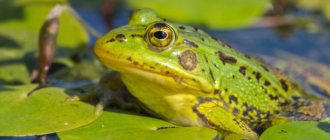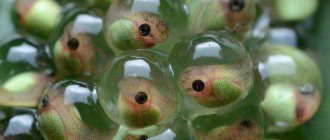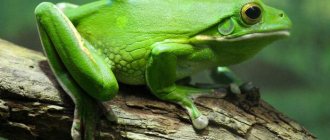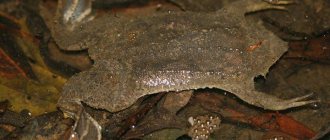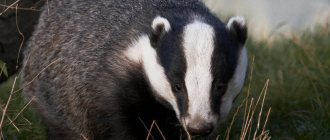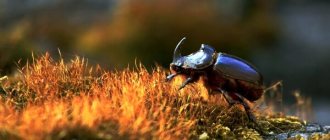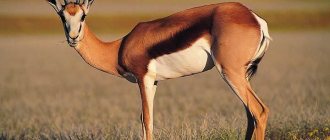Frogs are representatives of the most numerous order of tailless amphibians. The first ancestors of modern species appeared on the planet about 180-170 million years ago. In the process of evolution, frogs have spread throughout almost the entire planet, achieving significant species diversity. Thus, in the biological classification there are more than 7 thousand modern and about a hundred extinct species.
Let's look at the body structure of tailless amphibians, their life cycle and developmental features.
Characteristics and description
Most species of frogs lead a sedentary lifestyle, living within the same territory throughout their lives. Some representatives of the order make small migrations before the onset of the mating season.
The structure of the respiratory system, as well as the presence of resonators and bubbles, allows frogs to make a wide variety of sounds. Amphibians are characterized by periodic shedding of their skin.
The habitat and method of movement depend on the species: the order includes families that live near bodies of water, underground or in trees. Frogs are able to move on land, swim, dig holes and jump from branch to branch.
What sounds does a frog make?
Structural features
Frogs are amphibians, so their respiratory organs are adapted to life both on land and in water. On the shore of a reservoir, tailless animals breathe using their lungs, and in water they receive oxygen through their skin.
The internal structure of frogs has the following features:
- the circulatory system consists of a three-chambered heart and two circulation circles;
- the conclusions of the digestive and excretory systems are combined and end in the cloaca;
- the nervous system includes the brain, spinal cord and nerve endings;
- Frogs' sense of smell works only on land; in water they navigate using vision and hearing.
A distinctive feature of the skeleton is the presence of a urostyle - a long bone in the caudal part of the spine, formed from several vertebrae fused together.
What does it look like
The appearance of frogs has the following general characteristics:
- body shape oval, flattened on top;
- the head is flat with a short neck and bulging, clearly visible large eyes;
- the hind limbs are larger than the forelimbs, each paw has 4 regular fingers and one underdeveloped one;
- the skin is smooth and moist.
The traditional color for frogs is green, but some species are painted in rather unusual shades: blue, yellow, red, white, pink. Often the color of amphibians is a combination of stripes and spots of various colors.
CHAMELEON
Dimensions
Goliath
The largest frog is the goliath. The body length of an adult from head to toes on the hind legs reaches 90 cm, and the weight is 6 kg. The smallest representative of the order is cocoa. Its length does not exceed 3 cm. Below are the sizes of some varieties of frogs.
| View | Body length (without hind limbs), cm |
| Burrowing | 24,5 |
| Horned (or Itannia) | 20 |
| Five-fingered whistler | 18 |
| Herbal (or regular) | 10 |
| Wide-faced Litoria | 8 |
| Spotted cross | 5 |
| Black rain | 4 |
How is a frog different from a toad?
Frogs and toads belong to the same order. They can be distinguished by the following characteristics:
- Frogs are smaller, their body is covered with smooth skin, colored in various shades of green. Toads have a dark brown color, uneven skin, with a lot of wrinkles and pimples.
- Frogs have teeth, toads don't.
- The hind legs of toads are shorter.
- Frogs spend most of their time in water or near a reservoir, toads prefer land, and move to reservoirs only for the breeding season.
Dominican tree frog
Nowadays the Dominican tree frog is very popular among hobbyists .
She has a clumsy body, an incredibly wide head and a huge mouth.
Large bulging eyes and warty skin, which on the head grows to the skull and is therefore motionless, will add a pleasant impression. Their color changes not only depending on the temperature and humidity of the surrounding world, but even on their mood. Unlike other amphibians, Dominican tree frogs are predatory. Smaller frogs cannot be kept with them. These tree frogs are generally very voracious - they even eat newborn mice. Having devoured everything that turned up under the insatiable mouth, they do not feel any remorse, but are contentedly soloing. The cry of these gluttons is a trill of a series of successive quacks.
Types of frogs: photos and names
Let us consider in more detail the most interesting representatives of the order of tailless amphibians.
Hairy frog
Lives in the central part of the African continent. In male hairy frogs, before the mating season begins, the sides and hind legs are covered with thin flaps of skin resembling hairs. Adults are able to independently break the phalanges and remove them through the skin, resulting in the formation of claws at the ends of the fingers.
Javan flying frog
Found in the jungles of Southeast Asia. You can recognize it by its bright color (emerald green back and yellow belly), large eyes with horizontal pupils, and noticeably elongated toes on the front and hind legs.
The special structure of the paws with suction cups and skin membranes between the toes allows the Javan flying frog to make gliding jumps of 10-12 m.
Red-eyed tree frog
This small, brightly colored tree frog lives in southern North America. During the day, its color becomes more saturated and lighter, and with the onset of darkness it fades. Tree frogs are nocturnal. Due to the decrease in the area of tropical forests, the number of the species is steadily declining.
Glass frog
The main feature of the inhabitant of the tropical forests of Central and South America is the almost completely transparent skin on the stomach and paws. Through it you can see all the internal organs of the amphibian. Due to the transparency of the skin, bile salts in glass frogs remain in the bones and color them green, which improves camouflage.
Narrow-mouthed spadefoot
Also known as the Malagasy rainbow frog. Endemic to the island of Madagascar. The narrowmouth spends most of its life underground. The structure of the body and paws allows this species to move along vertical surfaces and find refuge in small crevices between stones. You can recognize a rainbow frog by its characteristic color: its skin is covered with spots of black, white, light green, orange and yellow of various shapes and sizes.
Lichen copepod
The second name of the species is mossy frog. It got its name from the presence of numerous tubercles and pimples covering the upper part of the body. Due to the rough surface of the skin and the predominance of brown and green shades in color, the copepod looks like a small pebble covered with moss.
Bernhard's Mantella / Mantella bernhardi
A resident of the island of Madagascar hides among fallen leaves, hunting for flies and other insects.
It has a characteristic black color, and males also have a horseshoe-shaped spot on their neck. Females do not have such a pattern, but they are larger in size than males.
A frog is not born poisonous, but over time the skin produces toxic poison, which leads to burns and allergies. This species of mantella leads the most active lifestyle among other African species.
4
Where do they live?
Frogs are found on all continents except Antarctica, as well as on most oceanic islands. Amphibians have adapted to life in temperate and cold climates, although their greatest species diversity is represented in the tropics and subtropics.
Where live
At the initial stage of development, the habitat of frogs is fresh water bodies. Adults live on land near lakes and rivers, in forests with high levels of humidity, and in swampy areas.
Range, habitats
Vertebrates have become widespread in almost all countries and continents, and are also found even in arctic snow conditions. But frogs give preference precisely to tropical forest zones, where there is simply a huge variety of species and subspecies of such amphibians. Frogs primarily inhabit fresh water bodies.
True frogs are members of the family Anura amphibians, which are almost universally distributed, with the exception of South America, southern Australia and New Zealand. Our country is inhabited mainly by the grass frog (Rana temporaria) and the pond frog (Rana esculenta).
It should be remembered that the distribution of some subspecies and species of frogs may well be limited by natural causes, including rivers, mountain ranges and deserts, as well as man-made factors represented by highways and canals.
In tropical conditions, the diversity of amphibian species is much greater than in zones characterized by cold or temperate climates. Certain species and subspecies of frogs are able to live even in salt waters or beyond the Arctic Circle .
How do they reproduce?
According to the type of behavior, frogs are divided into two types: with seasonal or with spontaneous reproduction. In the first case, the mating season occurs annually, and it begins in the same season. In the second case, the signal for reproduction is the onset of certain favorable conditions.
Frogs are characterized by external fertilization. During spawning, the male is on the female's back and covers the emerging eggs with sperm. Caviar has an oxygen-permeable shell. The duration of embryo maturation depends on the type and environmental conditions.
Stages of development
The larvae that hatch from the eggs are called tadpoles. They differ significantly from adult individuals and are adapted to life in water: breathing occurs with the help of gills, the body is elongated and has a fish-like tail, and the eyes are devoid of eyelids. The cubs have no teeth and eat plant matter.
After completion of the tadpole stage, which lasts from one to four months, metamorphosis occurs. This stage of development is characterized by a number of changes, during which the frogs acquire the features of adults. After metamorphosis is completed, they move into the habitat characteristic of their species.
Stages of frog development - video
Australian tree frog
In outline it somewhat resembles the Dominican one, but does not look so intimidating. Her back is bright green, her belly is white, and her eyes are golden. During the mating season, it acquires a sky-turquoise color. But if the Australian tree frog is capable of pleasing the eye, at least for lovers of exotica, its musical abilities are very doubtful. The male's voice resembles the distant barking of irritated dogs. The female's voice is louder and more shrill.
So, during your absence, you can place the aquaterrarium near the front door to scare away thieves. Just do not feed such a tree frog immediately before the “watchdog”. After a hearty lunch, she will sit down to “meditate” for a long time, comically folding her front paws.
How do frogs winter in nature?
Amphibians living in temperate and cold climates go into suspended animation during the winter. 1.5-2 months before going into hibernation, frogs begin to feed intensively, accumulating a supply of useful substances.
Some species survive the cold in water bodies, and some on land. In the first case, tailless animals sink to the bottom of a lake or river and burrow into the mud. For wintering, frogs select places where the water does not freeze completely. In the second case, before the onset of cold weather, amphibians burrow into the soil, moss or a thick layer of fallen leaves.
In winter, all metabolic processes slow down. In addition, part of the water in the blood is replaced by glycerol, and the resulting ice crystals do not damage the membranes of cells and tissues. This feature allows it to survive even if the frog’s body temperature drops below zero and it is partially or completely frozen.
With the onset of warmth, the tailless anurans, which are in a torpor, thaw and return to their normal way of life.
Garlic
Toads need a very spacious home. The soil in it should not be loose - otherwise your pets will sit in it all day long. The spadefoot spadefoot is considered an unsurpassed digger. It completely buries itself in the ground in 1-3 minutes, and does it backwards - backing away and desperately working with its hind legs, it disappears underground. The spadefoot rarely uses its voice, and this is undoubtedly its positive quality, because its timbre is very unique and high.
This toad makes a very loud squeal. It is curious that the tadpoles of the spadefoot toad reach a length of 10 cm, while the parents are only 5-6 cm. Another representative of the toad, the gray toad, is distinguished by its longevity: 30 years or more.
Who eats frogs
Anurans have no protective devices and are easy prey. Frogs and tadpoles are eaten by herons, storks, marsh harriers, eagle owls and other birds. Amphibians often complement the diet of predatory animals: foxes, bears, muskrats, martens. Snakes also hunt them.
Humans can also be considered natural enemies of frogs: more than 3 billion frog carcasses are used annually to prepare a variety of dishes. Archaeological excavations indicate that amphibians have been eaten since ancient times. Previously, adult individuals caught in their natural habitat were used for these purposes; currently, almost all carcasses are supplied to the market by frog farms. The so-called edible frog is used in cooking. The species belongs to the green frogs and is a hybrid obtained by crossing pond and lake frogs.
TRITON
You can eat, but you can't touch
One of the most powerful (and according to some sources, the most powerful) poisons of animal origin is the mucus of the tiny Colombian cocoa frog, whose weight does not exceed 1 g and height - 3 cm. But one such individual is enough to kill 1,500 people. At the same time, its poison is harmless when eaten, but the slightest amount of it that gets on a wound causes immediate paralysis and death. There is no antidote for it. By the way, the amphibian body does not know how to produce poison; it enters it with food.
The local Choco Indians, with great difficulty, obtain several specimens of cocoa in the jungle and hold them over the fire so that the poison appears on the skin, after which they smear their arrows with it. When dried, it retains its properties for up to 15 years.
Interesting facts about frogs
- Some species of frogs are poisonous and pose a danger to humans. Deadly species include the blue poison dart frog, the terrible leaf frog, phyllomedusa, toaded toad, and golden mantella. The habitat of most poisonous anurans is Central and South America. Since frogs do not generate toxic substances on their own, but obtain them by eating poisonous insects, they lose toxicity when changing their diet.
- Thanks to the special structure of their eyes, frogs are able to perform a circular view without changing their body position.
- From the moment the eggs are fertilized until the onset of sexual maturity, the frog goes through more than twenty different stages of development.
- Having swallowed prey that is too large, tailless animals push it to the stomach with the help of active rotation of their eyes.
- Frogs are common inhabitants of terrariums. The most suitable species for keeping at home are: sycamore, spadefoot, toaded toad, African dwarf frog.
Tree frogs
Among the tree frogs there are little ones the size of a fingernail and “giants” – up to 12 cm. Male tree frogs are desperate screamers. During vocalization, their throat swells greatly. And the main feature of tree frogs is the ability to masterfully climb and jump. The high glass walls of their home will not become an obstacle, because their legs have suction cups. They are capable of jumping from the wall of the aquaterrarium to the opposite one. Tree frogs are also wonderful chameleons.
They spend most of their time in natural conditions on trees, quickly changing color to match their environment. Their predominant colors are green and gold. In aquaterrariums they live up to 20 years. Of course, with careful care.
The longest-livers among amphibians can be considered the gray toad, whose life expectancy is 26 years, the crested python - up to 28 years, the toad - 20 = 29 years, the tree frog - 22 years, the grass and lake frog - 18 years, the clawed frog - 15 years. So if you already got a frog, take care of it!
Common Toad / Bufo bufo
The distribution area of the gray toad is quite extensive, from the Siberian expanses of Russia to the western tip of Europe and North Africa.
The largest toad living in Europe is also poisonous. The poisonous toad is especially dangerous to livestock, as well as to humans. It is extremely undesirable for the venom of this amphibian to get into the eyes or onto the oral mucosa.
Another interesting point: in times of danger, the toad takes a threatening pose, rising high on its paws.
3
Yeah / Rhinella marina
The poisonous tropical toad takes an honorable second place among all toads, but its toxicity makes it a leader among poisonous amphibians.
The largest specimen reached a size of 24 cm, although on average the toad grows from 15 to 17 cm. It comes from Central America, but to fight insects they were brought to Australia, from where Aga settled on the islands of Oceania.
The strongest poison affects the heart and affects the nervous system. The most dangerous thing is that the green toad can shoot poison over a distance.
1
Summarize
So we met some beautiful, but very dangerous frogs. Unfortunately, reports about people being poisoned by frogs quite often appear on news feeds. In nature, everything is thought out to the smallest detail, and the unusual color and appearance of amphibians acts as a kind of warning that this is a dangerous and poisonous creature.
The editors of TopCafe wish you to meet these amazing animals only on the screen or in a terrarium. We look forward to your comments about the most poisonous frogs on the planet.
Editor's note: This article has been updated since its original publication in November 2022.
Terrible leaf climber / Phyllobates terribilis
A small inhabitant of the rainforests on the southwestern tip of Colombia, the most poisonous frog in the world.
Adults grow no more than 2–4 cm, and the color is contrasting and quite bright. Yellow frogs are so poisonous that even a slight touch to it is enough to cause death. Phyllobates terribilis is born non-poisonous, and then, by consuming insects, it produces poison.
The most interesting thing is that in captivity, the Colombian poison frog gradually loses its poisonousness, since the diet does not contain insects, which contribute to the production of the deadly poison.
?
Phyllomedusa bicolor
Phyllomedusa bicolor (lat. Phyllomedusa bicolor)
Sometimes it is also called the “monkey frog”. A large individual that can boast of its two-color body, as its name immediately implies: its upper part is painted in a bright light green color, slightly yellow towards the edge of the transition down, where the second, brown side of the frog begins, which has light spots. She is very curious and can go anywhere in search of adventure. The venom of the bicolor phyllomedusa causes strong, not very pleasant hallucinations and stomach upset. However, some tribes living off the coast of the Amazon are deliberately “poisoned” with poison to induce hallucinations.
